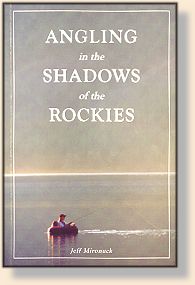Dry Flies and the Elk River, Part 2
By David Brown
Fishing and Floating the Elk River
The Elk River is a very user friendly river. There is good access
all the way along its course. The upper section from the Elk Lakes
down to Lime Creek is easy walk and wade water, the stretch from Lime
Creek to Elko is best suited to floating and the canyon stretch down
to the mouth can be tackled by rafting if you know what you are doing.
I spend most of my time on the floatable stretches above Elko, and
for first timers to the river the stretch from Hosmer to Fernie is a
good days float.
The drill for this river is to fish dry flies or streamers from the
boat, then stop and work the holding water, then move on to the next
spot. For the wading angler it's very much the same except you are
on foot as opposed to being in a boat. Success on this river means
working various types of holding water, everything from boulder gardens
to log jams can be found on this river, and more times then not they
harbor cutthroat trout.
Large holes are worth trying out. Streamer patterns and sink-tip lines
can be very effective. The long slow pools are the domain of the bull
trout, or Dolly Varden as it is called locally. They can grow up to
20 lbs.
Nymphing on the Elk means heavily weighted bead heads and yarn
indicators, very little external weight is needed for this river
and nymphing can produce some very good results as far as numbers
of fish are concerned.
Although the Elk River is easy to float, it can also turn into a
dangerous river if you are not cautious, the river has eaten a drift
boat from time to time so watch for sweepers and as a rule of thumb
stick to the main channel as much as possible.
Equipment
 If I had to choose one rod for the Elk River it would be a 9 ft 5 wt.
This rod can do anything required on this river, but owning one rod
is not as much fun and is perhaps the reason I get ugly looks for my
better half as I try to justify my latest addition to the arsenal. For
dry flies out of the boat I would use a 2 - 5 wt., 7 1/2 ft. For
throwing big attractor patterns from the boat a 9 ft, 4 - 6 wt. handles
the job quite nicely. As for chasing bull trout I like to use a #5 or #6
nine feet in length. Weight forward floating lines for all these rods
is all you need, however if you are serious about chasing bull trout
bring a 10 ft. sink tip just in case. Clothing for this part of the
world is important, rain gear is a must, along with a good pullover
fleece for when the sun starts to drop.
If I had to choose one rod for the Elk River it would be a 9 ft 5 wt.
This rod can do anything required on this river, but owning one rod
is not as much fun and is perhaps the reason I get ugly looks for my
better half as I try to justify my latest addition to the arsenal. For
dry flies out of the boat I would use a 2 - 5 wt., 7 1/2 ft. For
throwing big attractor patterns from the boat a 9 ft, 4 - 6 wt. handles
the job quite nicely. As for chasing bull trout I like to use a #5 or #6
nine feet in length. Weight forward floating lines for all these rods
is all you need, however if you are serious about chasing bull trout
bring a 10 ft. sink tip just in case. Clothing for this part of the
world is important, rain gear is a must, along with a good pullover
fleece for when the sun starts to drop.
In the summer months it is possible to wade wet, however do bring
along waders for those chilly days. Polarized sunglasses, sunscreen
and a hat are also necessary, don't forget your tour camera and film.
Anglers look for a place to camp should check out Fernie Provencial
park. If you are seeking motels, B&B's etc., I recommend calling
Fernie Reservations at 1-888-754-7325. ~ David Brown
About David Brown:
Growing up in Hamilton Ontariom David was introduced to the sport
of fly fishing at 15 years old. During those early years David cut
his teeth on smallmouth bass, native brook trout and Great Lake
Steelhead. He moved to Calgary Alberta in 1987 where he resides
in the off-guiding season. He began guiding on the Elk several
years ago and established the first guide service in the Fernie B.C.
area. You can reach him in Calgary at 403-285-1621 - during
fishing season in Fernie at 250-423-9231.
Credits: From Angling in the Shadows of the Rockies
by Jeff Mironuck. We thank
Frank Amato Publications, Inc. for use permission!
Our Man In Canada Archives
|


